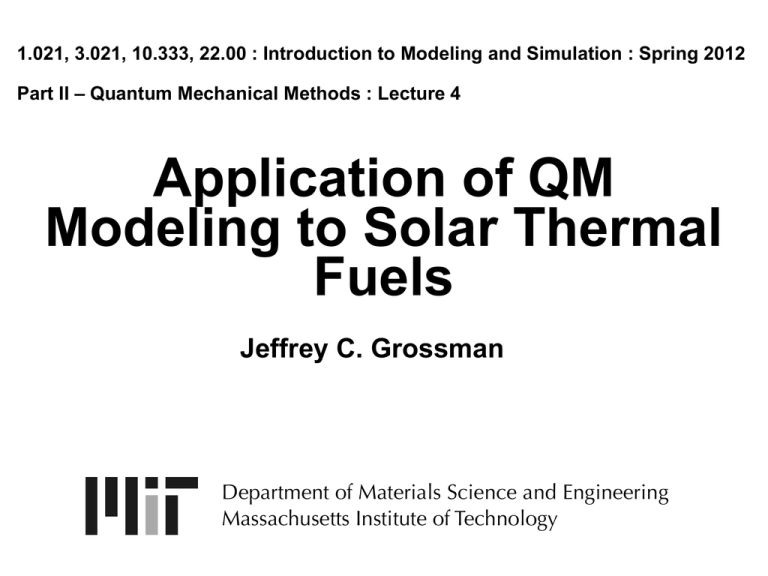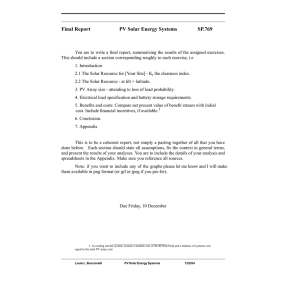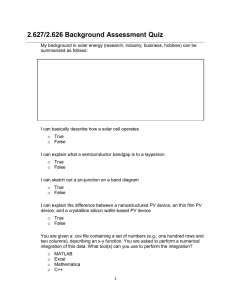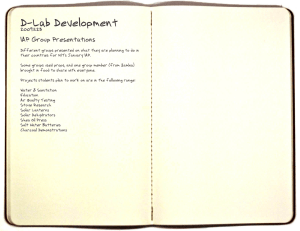
1.021, 3.021, 10.333, 22.00 : Introduction to Modeling and Simulation : Spring 2012
Part II – Quantum Mechanical Methods : Lecture 4
Application of QM
Modeling to Solar Thermal
Fuels
Jeffrey C. Grossman
Department of Materials Science and Engineering
Massachusetts Institute of Technology
Part II Topics
1.
2.
3.
4.
5.
6.
7.
8.
9.
10.
11.
It’s a Quantum World:The Theory of Quantum Mechanics
Quantum Mechanics: Practice Makes Perfect
From Many-Body to Single-Particle; Quantum Modeling of Molecules
Application of Quantum Modeling of Molecules: Solar Thermal Fuels
Application of Quantum Modeling of Molecules: Hydrogen Storage
From Atoms to Solids
Quantum Modeling of Solids: Basic Properties
Advanced Prop. of Materials:What else can we do?
Application of Quantum Modeling of Solids: Solar Cells Part I
Application of Quantum Modeling of Solids: Solar Cells Part II
Application of Quantum Modeling of Solids: Nanotechnology
Lesson outline
• Review
• Interactive calculations and discussion
on the H2
• First application of QM modeling:
Solar Thermal Fuels
• Interactive calculations and discussion
on candidate fuels.
Review: Next? Helium
e-
r1
+
r12
H1 = E1
e-
r2
H 1 + H2 + W
T1 + V1 + T2 + V2 + W
2
2m
⇥21
e2
4⇥
0 r1
2
2m
⇥22
cannot be solved analytically
e2
4⇥
0 r2
+
⇥
⇥
(⌥
r1 , ⌥
r2 ) = E (⌥
r1 , ⌥
r2 )
(r1 , r2 ) = E (r1 , r2 )
e2
4⇥
0 r12
⇥
⇤(r1 , r2 ) = E⇤(r1 , r2 )
problem!
Review:The MultiElectron Hamiltonian
H1 = E1
Remember
the good old days of the
1-electron H-atom??
2
2m
e2
⇥2
4⇥
0r
They’re
over!
2
2
2
⇥
⇤(r) = E⇤(r)
2
2
1
h
Zi e
1
e
h
2
2
∇ Ri + ∑∑
−
∇ ri − ∑∑
+ ∑∑
H = −∑
∑
2M i
2 i=1 j=1 ri − r j
2 i=1 j =1 Ri − R j 2m i=1
i=1
i=1 j=1 R i − r j
N
N N
Zi Z j e
n
N
n
i≠ j
kinetic energy of ions
n
n
i≠ j
kinetic energy of electrons
potential energy of ions
electron-electron interaction
electron-ion interaction
Multi-Atom-Multi-Electron Schrödinger Equation
H (R1 ,..., R N ;r1 ,..., rn ) Ψ (R1 ,..., R N ;r1 ,..., rn ) = E Ψ (R1 ,..., R N ;r1 ,..., rn )
Born-Oppenheimer Approximation
Electrons and nuclei
as “separate” systems
2
2
Z
1
e
e
h2
2
i
∇
−
+ ∑∑
H =−
∑
ri ∑∑
2m i=1
2 i=1 j =1 ri − r j
i=1 j=1 R i − r j
n
N
n
n
n
i≠ j
€
© source unknown. All rights reserved. This content is excluded from our Creative
Commons license. For more information, see http://ocw.mit.edu/help/faq-fair-use/.
Born-Oppenheimer Approximation
Electrons and nuclei
as “separate” systems
2
2
Z
e
1
e
h2
2
i
∇
−
+ ∑∑
H =−
∑
ri ∑∑
2m i=1
2 i=1 j=1 ri − r j
i=1 j=1 R i − r j
N
n
n
n
n
i≠ j
€
... but this is an
approximation!
• electrical resistivity
• superconductivity
• ....
© source unknown. All rights reserved. This content is excluded from our Creative
Commons license. For more information, see http://ocw.mit.edu/help/faq-fair-use/.
Review: Solutions
quantum chemistry
Moller-Plesset
perturbation theory
MP2
density
functional
theory
coupled cluster
theory CCSD(T)
Review:Why DFT?
100,000
g
10,000
n
ali
T
F
D
c
s
ar
e
Number of Atoms
n
Li
DFT
1000
MP2
100
QMC
CCSD(T)
10
Exact treatment
1
2003
2007
2011
2015
Year
Image by MIT OpenCourseWare.
Review: DFT
=
(⇧
r1 , ⇧
r2 , . . . , ⇧
rN )
n = n(⇤
r)
ele
de ctron
nsi
eas ty:
y!
:
n
o
i
t
c
n
u
f
wave licated!
p
m
o
c
Walter
Kohn
DFT
1964
© unknown. All rights reserved. This content is excluded from
our Creative Commons license. For more information,
see http://ocw.mit.edu/help/faq-fair-use/.
All aspects of the electronic structure of a system
of interacting electrons, in the ground state, in
an “external” potential, are determined by n(r)
Review: DFT
electron density
ion
The ground-state energy is a
functional
of the electron density.
E[n] = T [n] + Vii + Vie [n] + Vee [n]
kinetic
ion-ion
ion-electron
electron-electron
The functional is minimal at the exact
ground-state electron density n(r)
The functional exists... but it is unknown!
© source unknown. All rights reserved. This content is excluded from our Creative Commons license. For more information, see http://ocw.mit.edu/fairuse.
Review: DFT
E[n] = T [n] + Vii + Vie [n] + Vee [n]
kinetic
ion-ion
ion-electron
electron density n(⌅r) =
i
electron-electron
r )|
|ci (⌅
2
Eground state = min E[n]
c
Find the wave functions that minimize the
energy using a functional derivative.
Review: DFT
Finding the minimum leads to
Kohn-Sham equations
ion potential
Hartree potential
exchange-correlation
potential
equations for non-interacting electrons
Review: DFT
Only one problem: vxc not known!
approximations necessary
local density
approximation
LDA
general gradient
approximation
GGA
Review: Self-consistent cycle
Kohn-Sham equations
Iterations to selfconsistency
sc
f lo
n(⌅
r) =
i
|ci (⌅
⌅
r )|
2
3.021j Introduction to Modeling and Simulation - N. Marzari (MIT, May 2003)
op
scf loop
Review: DFT calculations
total
total
total
total
total
total
total
energy
energy
energy
energy
energy
energy
energy
=
=
=
=
=
=
=
-84.80957141
-84.80938034
-84.81157880
-84.81278531
-84.81312816
-84.81322862
-84.81323129
Ry
Ry
Ry
Ry
Ry
Ry
Ry
exiting loop;
result precise enough
1)
electronic
charge
density
At the end we get:
2) total energy
Structure
Elastic
constants
Vibrational
properties
...
Review: Basis functions
⇥=
Matrix eigenvalue equation:
i
expansion in
orthonormalized basis
functions
H1 = E1
ci ci = E
H
⇥
i
ci ci = E
d⌥
r cj H
i
ci ci
⇥i
Hji ci = Ecj
i
H⇤
c = E⇤
c
ci ci
ci ci
d⌥
r cj
i
Review: Plane waves as
basis functions
plane wave expansion:
⇧ j ·⇧
iG
r
(⇧
r) =
cj e
j
plane wave
Cutoff for a maximum G is necessary and results in a finite basis set.
Plane waves are periodic,
thus the wave function is periodic!
periodic crystals:
Perfect!!!
Image by MIT OpenCourseWare.
atoms, molecules:
OK but be careful!!!
First Application Example:
Solar Chemical Fuels
Materials will determine
the future of renewable energy
Solar PV
Biofuels
Batteries
Thermoelectrics
Solar Thermal
Hydrogen Storage
Thermoelectrics © D. J. Paul; hydrogen storage © Berkeley Lab; other images © sources unknown. All rights reserved. This
content is excluded from our Creative Commons license. For more information, see http://ocw.mit.edu/help/faq-fair-use/.
The Materials Design Age
• Stone Age
• Iron Age
• Bronze Age
• Industrial Age
• Plastic Age
• Silicon Age
• Materials
Design
Images © sources unknown. All rights reserved. This content is excluded from our Creative
Commons license. For more information, see http://ocw.mit.edu/help/faq-fair-use/.
Let’s look at a single element:
carbon
Nanotube architecture © John Hurt; graphene integrated circuit © Raghu Murali; other images © sources unknown. All rights reserved.
This content is excluded from our Creative Commons license. For more information, see http://ocw.mit.edu/help/faq-fair-use/.
Carbon in Energy to Date
One Barrel of oil
(159 liters) =
1.73 MWh of energy.
© sources unknown. All rights reserved. This content is excluded from our Creative Commons license. For more information, see http://ocw.mit.edu/help/faq-fair-use/.
Same C:
5
10
X Improvement
That same 1 barrel could be used to make the
plas8c needed for thin-­‐film solar cells.
© sources unknown. All rights reserved. This content is excluded from our Creative
Commons license. For more information, see http://ocw.mit.edu/help/faq-fair-use/.
The solar cells could generate ~16,000 MWh of
energy over their life2me, or 10,000 X as much
Solar Resource
Perez et al.
© Richard Perez. All rights reserved. This content is excluded from our Creative
Commons license. For more information, see http://ocw.mit.edu/help/faq-fair-use/.
Solar Energy Harvesting
Solar Thermal
Photovoltaics
40000 TW
Crescent Dunes, NV © source unknown. All rights reserved.
© source unknown. All rights reserved.
Photosynthesis
15 TW
Solar Thermal Fuels
© source unknown. All rights reserved.
Copyrighted content on this page is excluded from our Creative Commons license. For more information, see http://ocw.mit.edu/help/faq-fair-use/.
Solar to Heat
Hot Water
Parabolic Dish / Stirling Engines
es
Reflectors (Parabolic Troughs)
Solar Towers (a.k.a. “Power Towers”)
From left (clockwise): SES SunCatcher solar dish © Stirling Energy Systems, barrels, reflectors, parabolic troughs, PS10 in Seville © sources unknown.
All rights reserved. This content is excluded from our Creative Commons license. For more information, see http://ocw.mit.edu/help/faq-fair-use/.
Solar Thermal: Sunlight-­‐-­‐>Heat: ConcentraAng
PS10, 11 MW Solar Tower (Sanlucar la Mayor, Seville)
Left: PS10, 11 MW Solar Tower in Sanlucar la Mayor, Seville © source unknown. Right: from Weiss, W. I. Bergmann, and G. Faninger. "Solar heat
worldwide 2008: Markets and contributions to the energy supply 2006" © International Energy Agency. All rights reserved. This content is
excluded from our Creative Commons license. For more information, see http://ocw.mit.edu/help/faq-fair-use/.
Challenges with Solar Thermal Power:
• Losses in storage
• Auxiliary hea2ng
• Highly reflec2ve coa2ngs + tracking
• Large footprint and cost
• Not transportable, no distribu2on “as heat”
USA has not widely
adopted Solar
Water Heating.
REN21. 2008. “Renewables 2007 Global Status Report.
”© Deutsche GTZ GmbH. "All rights reserved.
USA
From Weiss, W. I. Bergmann, and G. Faninger. "Solar heat worldwide 2008: Markets and contributions to the energy supply 2006." © International Energy
Agency. Copyrighted content on this page is excluded from our Creative Commons license. For more information, see http://ocw.mit.edu/help/faq-fair-use/.
Some Challenges with Solar Thermal
§Losses in storage
§Auxiliary heating
§Highly reflective (and clean)
coatings
§Tracking components
§Large storage facilities
§Not transportable, can’t be
distributed “as heat”
11 MW Solar Tower in Sanlucar la Mayor, Seville © source unknown. All rights
reserved. This content is excluded from our Creative Commons license. For
more information, see http://ocw.mit.edu/help/faq-fair-use/.
Solar-Chemical :
Heat stored in chemical bonds
Charging
Old Idea,
BUT: rapid
degradation
for ALL
cases.
Heat
Discharging
Blast from the past (70’s/80’s)…
hν
+ 1.14 eV/molecule
Δ
Norbornadiene
Quadricyclane
BUT: Poor cycling, rapid degrada;on for ALL cases.
“… a photochemical solar energy storage plant, although technically feasible, is not economically jus3fied.”
Ind. Eng. Chem. Prod. Res. Dev., 1983, 22 (4), pp 627–633
Decomposition products
hν
Norbornadiene:
Starts to decompose at ~600K, or with repeated cycling
Quadricyclane:
Starts to decompose at ~500 K
Δ
Δ
+
Δ
Cyclopentadiene
Toluene
Cycloheptatriene
Stable up to ~1000 K
Acetylene
(acetylene eliminaAon via reverse Diels-­‐Alder)
J. Phys. Chem. A 102, 9202-­‐9212 (1998)
Efforts to prevent decomposition
Images removed due to copyright restrictions. See article: Alexander D Dubonosov et al. Russian Chemical Reviews 71, no. 11 (2002): 917-27.
“donor-­‐acceptor” norbornadienes: ~103 cycles
2,3-­‐disubsAtuted norbornadienes: can be cycled “many Ames”
No magic bullet – always a trade-­‐off between: § quantum yield § absorp2on efficiency § stored energy § thermal stability of the quadricyclane
§ cyclability
Russian Chem. Rev. 71, 917-­‐927 (2002)
Why revisit solar thermal fuels
now?
ComputaOonal power for high-­‐throughput materials design
Rapid computaOonal screening of thousands of materials
Example: Time to perform calculaOons for 100,000 known crystalline materials:
1980: 30 years
2012: few days
+
Technology for atomic-­‐scale engineering
PotenOal to synthesize systems designed with atomic-­‐scale control
The Ome is ripe to tackle this generaOon-­‐old concept with a new “arsenal” of science/
technology capabiliOes.
A novel approach to solar
thermal fuels
'*' !$
#,,,
,,, #,
ν
Δ
@
ν
Δ
ν
@A
/&(
Δ
-*$,)*5,(@',)5($(
% # )
A new approach: combine
photomolecule with template
excited state
N
hν
uncharged
N
N
N
charged
Ea
ΔH
The azobenzene/CNT system
§ Already synthesized* § Photoac3vity experimentally demonstrated*
§ Not previously considered for energy storage
*e.g., see Feng, et. al, J. Appl. Phys. (2007); Simmons et. al, PRL (2007)
trans-azobenzene/CNT
Role of the CNT template
Role of the CNT template
Intermolecular SeparaAon (A)
Rigid substrate – fixes inter-­‐molecular distances over long range, enabling:
§ steric inhibiOon
§ π-­‐stacking
§ hydrophobic interacOons
Enables design of specific intermolecular interacOons – not available in free azobenzene
Stores More Energy
Stability
Energy density comparison
system
state
energy density (Wh/L)
Ru-fulvalene
solution (toluene)
0.02
azobenzene
solution (H2O)
0.000002
azobenzene
powder
90
azobenzene/CNT
soln. or powder
up to 690
Li-ion battery
200-600
New Materials for Solar
Thermal Fuels
ν
Δ
Δ
ν
ν
Δ
6
New Chemistry Platform
for Solar Thermal Fuels
5
!$#
Solar Thermal Fuel
Applications
•
•
•
•
•
•
•
•
•
•
•
•
•
Solar cooker: developing countries
Solar cooker: hiking & outdoor / military
Solar autoclave: developing countries
Medical sanitaAon
Milk pasteurizaAon: rural
Thin film window heaAng supplement
On-­‐site storage: power generaAon
Gas/oil industry
Military off-­‐grid heat
Building heaAng
NASA/mariAme
CSP auxiliary heat supply
De-­‐icing (windows, planes, power lines)
45
The Case for Solar Cookers
Problems with Cooking Off-­‐Grid ‣ Cooking fuel (e.g., wood) is increasingly scarce, expensive, and Ame-­‐intensive to find
‣ Smoke in not-­‐well venAlated areas causes respiratory problems
Exis;ng Solar Ovens
‣ Can only cook while the sun is out
‣ Are cumbersome and heavy to transport
‣ Cannot be turned ‘on’ and ‘off’
Images of outdoor cookers and solar oven © sources unknown. All rights reserved.
This content is excluded from our Creative Commons license. For more
information, see http://ocw.mit.edu/help/faq-fair-use/.
Solar Cooker: Using the Sun to Cook at Night
Stove Top
Fuel Flow
During
Charging
Day Charging
Fuel Flow
for
cooking
Night Cooking
• Charging: slow flow through solar collector during the day. • Cooking: device is turned upside down. • Cost esAmate <$200. Weight=<5 kg, floor space=1 sq. p.
• 5 hours of charge Ame = boil liters of water or cook at 300C for ~1 hour.
47
Materials Design Full Cycle
Simulation
Synthesis
Prototype
Testing
Grossman Group, MIT.
So Why do We Need QM?
excited state
hν
Ea
ΔH
Solar radiation spectrum © Robert A. Rohde/Global Warming Art. License: CC-BY-SA. This content is excluded
from our Creative Commons license. For more information, see http://ocw.mit.edu/help/faq-fair-use/.
49
MIT OpenCourseWare
http://ocw.mit.edu
3.021J / 1.021J / 10.333J / 18.361J / 22.00J Introduction to Modelling and Simulation
Spring 2012
For information about citing these materials or our Terms of Use, visit: http://ocw.mit.edu/terms.



